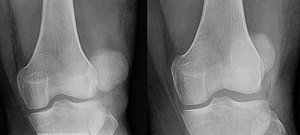Luxating patella
| Luxating patella | |
|---|---|
 |
|
| Patella luxation on radiograph. Left before, right after reduction. After reduction the patella is still displaced. | |
| Classification and external resources | |
| Specialty | rheumatology |
| ICD-10 | M22.1 |
| ICD-9-CM | 836.3, 836.4 |
Luxating patella (or trick knee, subluxation of patella, floating patella, or floating kneecap) is a condition in which the patella, or kneecap, dislocates or moves out of its normal location.
Patellar luxation is a common condition in dogs, particularly small and miniature breeds. The condition usually becomes evident between the ages of 4 to 6 months. It can occur in cats as well, especially the Domestic Shorthair.
It also occurs in humans, where it can be associated with damage to the anterior cruciate ligament.
Most cases of patellar luxation are medial and this is frequently a congenital problem in toy and miniature breed dogs. Breeds showing a predisposition for medial patellar luxation include miniature and toy Poodles, Maltese, Jack Russell Terriers, Yorkshire Terriers, Pomeranians, Pekingese, patterdale terrier, Chihuahuas, Cavalier King Charles Spaniels, Papillons, Boston Terriers, Plummer Terriers and Teddy Roosevelt Terriers. Large breed dogs are also affected and the Labrador retriever seems particularly predisposed. Patellar luxation is less common in cats than in dogs. Predisposed breeds include the Devon Rex and the Abyssinian. Although the specific cause of patellar luxation is unknown in these cases, it is generally agreed that a defect in hind limb conformation is the underlying cause.
...
Wikipedia
